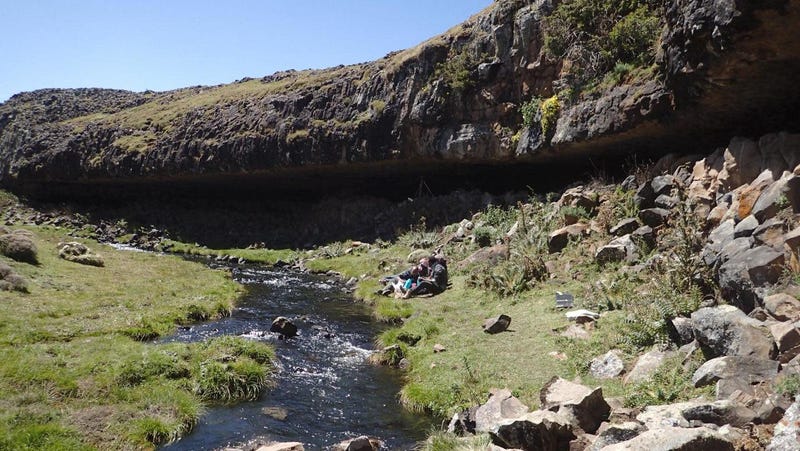
Archaeologists working within the Bale Mountains of Ethiopia absorb uncovered the earliest evidence to this point of human habitation in a excessive-altitude ambiance. Dwelling over 11,000 toes above sea level, these early mountaineers ate rodents to outlive the harsh ice age prerequisites.
Unique evaluation published this week in Science describes the oldest identified human occupancy of a excessive-altitude ambiance. Between 47,000 and 31,000 years ago, Stone Age foragers occupied a rock refuge within the Bale Mountains of Ethiopia, which is 11,381 toes (3,469 meters) above sea level. The authors of the original watch, led by researchers from Martin Luther College, aren’t particular if the refuge modified into once extinct intermittently or if the occupation modified into once permanent.
Indeed, it appears to be like improbable that someone, least of which foragers from the Center Paleolithic period, would wish to try this reputedly inhospitable plot their house. At these excessive altitudes, humans are subject to hypoxia—a condition by which the body doesn’t procure ample oxygen. Hypoxia might possibly finish up in dizziness, shortness of breath, organ failure, and most regularly loss of life. Mountains also have a tendency to characteristic climate extremes, such as wild temperature fluctuations and copious portions of rain. Resources, such as meals, also are usually scarce in excessive-altitude areas.
No matter these hardships, early humans dared to do mountains their house. A range of examples within the archaeological literature embody occupations of the Tibetan Plateau (round 3,600 years ago primarily based on archaeological evidence) and the Andean Highlands of Peru (between 6,800 and 1,400 years ago), nonetheless the occupation at the Fincha Habera rock refuge in southern Ethiopia is now knowing in regards to the oldest example of excessive-altitude residing (importantly, this involves habitation of some variety, and no longer unprejudiced right ventures as much as the mountains to acquire sources).
In say for these Paleolithic humans to resettle and use a whereas within the harsh Bale Mountains, there needed to be the associated pushes and pulls.
By blueprint of the push, the foragers had been having to deal with nerve-racking ice age prerequisites. Because the original evaluation functions out, the valleys nearby had been drying out, forcing the Stone Age humans to fetch original areas to dwell.
By blueprint of the pull, the Bale Mountains, possibly surprisingly, had rather a minute to give. Excavations done over three years at the Fincha Habera rock refuge published troves of artifacts, including stone instruments—some made from obsidian—loads of pottery shards, and a single glass bead. The archaeologists also discovered burnt animal bones and the hearths of venerable fires. Radiocarbon dating of this stuff placed habitation at the residing from between 47,000 and 31,000 years ago.
The sheer quantity of mole-rat stays discovered at the residing suggests the humans’ diet primarily consisted of these rodents. Mole-rats had been well-known, easy to hunt, and contained enough portions of protein for survival, in step with the original evaluation.
The researchers, led by MLU’s Bruno Glaser, extinct modern ideas to title extinct climate patterns and to analyze soil samples discovered in and round the residing. Within the route of the ice age, this keep of the Bale Mountains modified into once located unprejudiced right past the southernmost encroachment of the nearest glaciers. Because of fluctuating climate patterns and phases of glacial melting, the of us that lived within the house doubtless had easy entry to original water.
Within the ruin, nearby volcanic deposits of obsidian represented one other attention-grabbing reason to preserve within the keep. These rocks can uncover extremely curious when they’re knapped, making them a prized resource of the Stone Age.
“The settlement modified into once therefore no longer supreme comparatively habitable, nonetheless also incandescent,” acknowledged Glaser in a press launch.
The researchers issue prolonged occupation at the Fincha Habera rock refuge is a obvious possibility, nonetheless they don’t absorb ample evidence to point it. Writing in a connected Science Perspective, anthropologist Value Aldenderfer from the College of California, counseled the authors for no longer speculating past the available evidence:
Within the original work, Ossendorf et al. in moderation describe every the functions of the Fincha Habera rock refuge and the differ of artifacts recovered at the residing. In their conclusions, the authors outlined Fincha Habera as a “residential execrable” nonetheless issue minute in regards to the duration or season of occupation of the residing. Their restraint is admirable attributable to it would absorb been tempting to invest whether or no longer the residing modified into once occupied completely. They present this possibility nonetheless are mindful that their knowledge can no longer make stronger the claim. They also picture that the residing might well absorb been portion of a settlement system sharp the very blueprint lowlands.
Apparently, the researchers also discovered evidence of occupation at the rock refuge starting up round 10,000 years ago. Within the route of this second portion of occupation, its inhabitants more and more extinct the residing as a fireplace, and evidence taken from the soil within the beget of animal excrement supposed grazing animals had at closing ventured to the keep.
It appears to be just like the later inhabitants had graduated from mole-rats—no query a necessary enchancment in their quality of life.
View Source










Post A Comment: